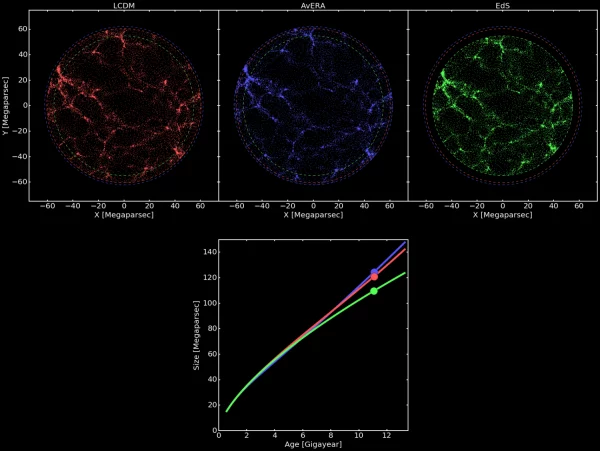Gravitational force, one of the four fundamental forces in the universe, has long been a subject of study for astronomers. However, while we have a fairly good understanding of its effects in solar systems and galaxies, the vastness of the universe still holds many mysteries that remain unexplained. Astronomical physicists are currently working hard to unravel strange phenomena related to gravity while also explaining the changes and expansion of the universe.
In 1998, scientists made a surprising discovery: not only is the universe expanding, but it is also accelerating its expansion over time. This finding was shocking, as according to Einstein’s theory of general relativity, gravity should be pulling galaxies together, causing the universe to slow down, preventing it from expanding forever. However, data from distant supernovae revealed that the universe is not only not slowing down but accelerating, raising the question: is there a force other than gravity that is influencing the universe?
One of the theories proposed to explain this is “dark energy” – a form of energy that exists in space and has the ability to push the universe apart, accelerating its expansion. Dark energy cannot be observed directly, but its effects have been identified by scientists through observable signs from celestial bodies.
“Dark energy is present everywhere in space, and it is causing the accelerating expansion of the universe. However, it remains a mystery that has yet to be fully explained.” – NASA Astrophysics Research Institute, 2021.
However, a group of astrophysicists proposed another theory, which is the existence of a “fifth force” beyond the known fundamental forces such as gravity, electromagnetism, and the strong and weak nuclear forces. This theory, known as “modified gravity,” suggests that gravity may not work the same way everywhere in the universe. Such changes could occur on a cosmic scale, such as between galaxies, where gravity might be altered by another factor, not just the mass of objects.
Astronomical physicist Bhuvnesh Jain from the University of Pennsylvania is one of the leading researchers studying this phenomenon. He and his colleagues conducted an in-depth study of Cepheid variable stars, which are stars that oscillate regularly in brightness. These stars are bright enough to be observed and are commonly used to measure distances between celestial objects. “If gravity is affected by a fifth force, it would accelerate the oscillation of Cepheid stars,” Jain explained.
“We have been able to rigorously test Einstein’s theory and narrow the space for other theories. This has led to the exclusion of many current hypotheses.” – Bhuvnesh Jain, University of Pennsylvania, 2022.
By comparing data collected from nearby galaxies, Jain and his team conducted a thorough experiment on the variation of gravitational forces. They found no significant difference in how Cepheid stars oscillate between galaxies with and without the influence of the fifth force. This result supports Einstein’s general relativity theory and dismisses the possibility of a powerful fifth force existing as an alternative theory to dark energy.
This research not only clarifies doubts about gravitational forces but also opens a new path in understanding more about the universe and its expansion. As data from new telescopes, such as the James Webb Space Telescope, help us explore distant galaxies, the big questions surrounding the expansion of the universe will become clearer.

By understanding gravitational forces and other factors that influence the universe, scientists are not only decoding the development of galaxies but also bringing us closer to a comprehensive picture of the universe we live in. These discoveries not only provide new insights into the universe but also inspire the next generations to continue exploring space and searching for the remaining cosmic mysteries.


HPX24h > Space > Exploring Gravitational Forces and the Evolution of the Universe
Top Reads from This Category
Space
The Smallest Star System with Three Exoplanets Found by NASA’s Kepler
Space
Exploring a New Super-Earth: Could It Support Life?
Space
Jupiter-Like Planets: The Key to Unlocking Earth-Like Worlds
Space
Gamma Ray Bursts and the Key to the Chemical Composition of the Early Universe
Space
Three Earth-Like Planets That Could Support Life: New Discovery from NASA
Space
The Two Largest Black Holes Ever Discovered
Space
The Milky Way’s Central Black Hole: The Asteroid Annihilator
Discover New Topics
Healthy Eating
Types of Fats: Can Fats Be Good for You?
Fitness
How Often Should You Work Out Each Week for Effective Weight Loss and Muscle Gain?
Science
Turning Dreams On and Off with Brain-Control Technology: A Breakthrough in Sleep Researc
Health
Are ‘Forever Chemicals’ Present in Bandages? How This Could Affect Your Health
Health
Exploring How Microplastics Enter the Body and Affect Health
Science
Innate Intelligence: What Role Do Genetics Play in Developing High IQ
Healthy Eating
Robert F. Kennedy Jr.: “We Are Being Poisoned Without Knowing It”
Fitness
HIIT: The Ultimate Shortcut to Efficient and Comprehensive Fitness
Healthy Eating
Health is ‘Declining’ Due to Processed Foods: How to Turn the Tide
Healthy Eating
The optimal diet for leaky gut syndrome: Scientific solutions and practical advice
Science
Cow-Free Milk: The Food Revolution Shaping Our Future
Healthy Eating
5 Serious Consequences of Eating Too Much Sugar That You Didn’t Expect
Healthy Eating
Vegan Keto Diet: Everything You Need To Know